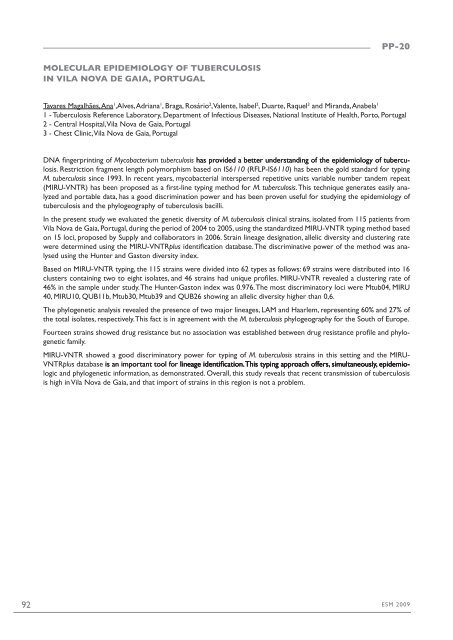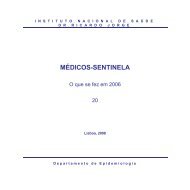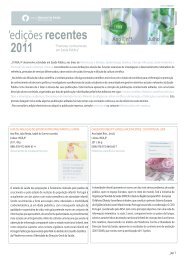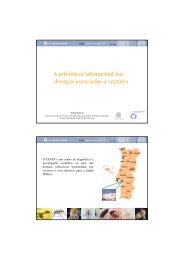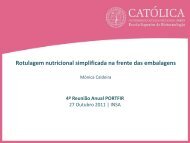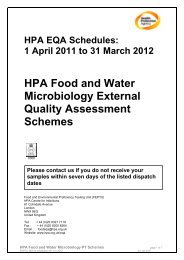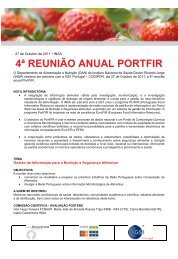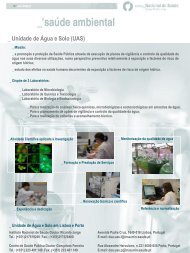European Society of Mycobacteriology - Instituto Nacional de Saúde ...
European Society of Mycobacteriology - Instituto Nacional de Saúde ...
European Society of Mycobacteriology - Instituto Nacional de Saúde ...
You also want an ePaper? Increase the reach of your titles
YUMPU automatically turns print PDFs into web optimized ePapers that Google loves.
PP-20<br />
MOLECULAR EPIDEMIOLOGY OF TUBERCULosis<br />
IN VILA NOVA DE GAIA, PORTUGAL<br />
Tavares Magalhães, Ana 1 , Alves, Adriana 1 , Braga, Rosário 2 , Valente, Isabel 2 , Duarte, Raquel 3 and Miranda, Anabela 1<br />
1 - Tuberculosis Reference Laboratory, Department <strong>of</strong> Infectious Diseases, National Institute <strong>of</strong> Health, Porto, Portugal<br />
2 - Central Hospital, Vila Nova <strong>de</strong> Gaia, Portugal<br />
3 - Chest Clinic, Vila Nova <strong>de</strong> Gaia, Portugal<br />
DNA fingerprinting <strong>of</strong> Mycobacterium tuberculosis has provi<strong>de</strong>d a better un<strong>de</strong>rstanding <strong>of</strong> the epi<strong>de</strong>miology <strong>of</strong> tuberculosis.<br />
Restriction fragment length polymorphism based on IS6110 (RFLP-IS6110) has been the gold standard for typing<br />
M. tuberculosis since 1993. In recent years, mycobacterial interspersed repetitive units variable number tan<strong>de</strong>m repeat<br />
(MIRU-VNTR) has been proposed as a first-line typing method for M. tuberculosis. This technique generates easily analyzed<br />
and portable data, has a good discrimination power and has been proven useful for studying the epi<strong>de</strong>miology <strong>of</strong><br />
tuberculosis and the phylogeography <strong>of</strong> tuberculosis bacilli.<br />
In the present study we evaluated the genetic diversity <strong>of</strong> M. tuberculosis clinical strains, isolated from 115 patients from<br />
Vila Nova <strong>de</strong> Gaia, Portugal, during the period <strong>of</strong> 2004 to 2005, using the standardized MIRU-VNTR typing method based<br />
on 15 loci, proposed by Supply and collaborators in 2006. Strain lineage <strong>de</strong>signation, allelic diversity and clustering rate<br />
were <strong>de</strong>termined using the MIRU-VNTRplus i<strong>de</strong>ntification database. The discriminative power <strong>of</strong> the method was analysed<br />
using the Hunter and Gaston diversity in<strong>de</strong>x.<br />
Based on MIRU-VNTR typing, the 115 strains were divi<strong>de</strong>d into 62 types as follows: 69 strains were distributed into 16<br />
clusters containing two to eight isolates, and 46 strains had unique pr<strong>of</strong>iles. MIRU-VNTR revealed a clustering rate <strong>of</strong><br />
46% in the sample un<strong>de</strong>r study. The Hunter-Gaston in<strong>de</strong>x was 0.976. The most discriminatory loci were Mtub04, MIRU<br />
40, MIRU10, QUB11b, Mtub30, Mtub39 and QUB26 showing an allelic diversity higher than 0,6.<br />
The phylogenetic analysis revealed the presence <strong>of</strong> two major lineages, LAM and Haarlem, representing 60% and 27% <strong>of</strong><br />
the total isolates, respectively. This fact is in agreement with the M. tuberculosis phylogeography for the South <strong>of</strong> Europe.<br />
Fourteen strains showed drug resistance but no association was established between drug resistance pr<strong>of</strong>ile and phylogenetic<br />
family.<br />
MIRU-VNTR showed a good discriminatory power for typing <strong>of</strong> M. tuberculosis strains in this setting and the MIRU-<br />
VNTRplus database is an important tool for lineage i<strong>de</strong>ntification. This typing approach <strong>of</strong>fers, simultaneously, epi<strong>de</strong>miologic<br />
and phylogenetic information, as <strong>de</strong>monstrated. Overall, this study reveals that recent transmission <strong>of</strong> tuberculosis<br />
is high in Vila Nova <strong>de</strong> Gaia, and that import <strong>of</strong> strains in this region is not a problem.<br />
92 ESM 2009


